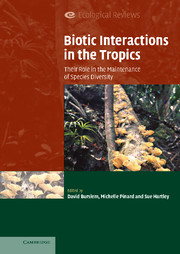Book contents
- Frontmatter
- Contents
- List of contributors
- Preface
- PART I Plant–plant interactions
- PART II Plant–microbe interactions
- 6 Dimensions of plant disease in tropical forests
- 7 Mycorrhizas and ecosystem processes in tropical rain forest: implications for diversity
- 8 An overview of arbuscular mycorrhizal fungal composition, distribution and host effects from a tropical moist forest
- 9 Tropical plants as chimera: some implications of foliar endophytic fungi for the study of host-plant defence, physiology and genetics
- PART III Plant–animal interactions
- PART IV Biotic interactions in human-dominated landscapes
- Index
- References
8 - An overview of arbuscular mycorrhizal fungal composition, distribution and host effects from a tropical moist forest
Published online by Cambridge University Press: 25 August 2009
- Frontmatter
- Contents
- List of contributors
- Preface
- PART I Plant–plant interactions
- PART II Plant–microbe interactions
- 6 Dimensions of plant disease in tropical forests
- 7 Mycorrhizas and ecosystem processes in tropical rain forest: implications for diversity
- 8 An overview of arbuscular mycorrhizal fungal composition, distribution and host effects from a tropical moist forest
- 9 Tropical plants as chimera: some implications of foliar endophytic fungi for the study of host-plant defence, physiology and genetics
- PART III Plant–animal interactions
- PART IV Biotic interactions in human-dominated landscapes
- Index
- References
Summary
Introduction
Arbuscular mycorrhizal fungi (AMF) (Zygomycetes) are an ancient group, dating back to the invasion of land surfaces by plants. Currently, they are perhaps the most abundant soil fungi, and they form intimate relationships with the roots of the vast majority of terrestrial plant species across the planet. These fungal symbionts generally play a mutualistic role, aiding the host plant primarily by enhancing the acquisition of soil nutrients, particularly phosphorus (P). In addition, AMF species often affect plant hormone production/induction (Allen et al. 1980), resistance to root pathogens (Newsham et al. 1995); water uptake (Kyllo et al. 2003) and soil structure (Andrade et al. 1998; Rillig & Allen 1999). In return, all AMF species obligately depend on the host plant for photosynthetically fixed carbon. Given their obligate dependence, AMF are influenced by their hosts at essentially every phase in their life history – hyphal development, sporulation and spore germination (Hetrick & Bloom 1986; Sanders & Fitter 1992; Bever et al. 1996). On the other hand, the degree of mycorrhizal dependence often varies widely among the host plant species in a community (Janos 1980a; Azcon & Ocampo 1981; Hetrick et al. 1992; Kiers et al. 2000).
A central and still largely unanswered question is the degree to which host plant and AMF species influence each other's community composition in natural systems. Fundamentally, for community effects to occur, different combinations of host and AMF species must produce different outcomes of survival and growth.
- Type
- Chapter
- Information
- Biotic Interactions in the TropicsTheir Role in the Maintenance of Species Diversity, pp. 204 - 225Publisher: Cambridge University PressPrint publication year: 2005
References
- 11
- Cited by

